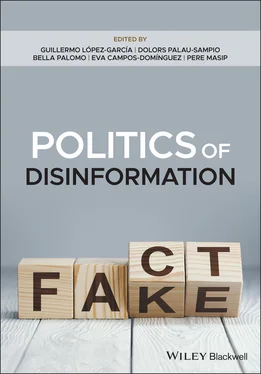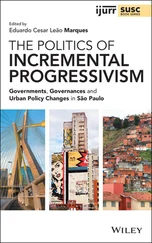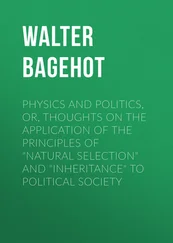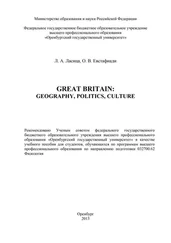Politics of Disinformation
Здесь есть возможность читать онлайн «Politics of Disinformation» — ознакомительный отрывок электронной книги совершенно бесплатно, а после прочтения отрывка купить полную версию. В некоторых случаях можно слушать аудио, скачать через торрент в формате fb2 и присутствует краткое содержание. Жанр: unrecognised, на английском языке. Описание произведения, (предисловие) а так же отзывы посетителей доступны на портале библиотеки ЛибКат.
- Название:Politics of Disinformation
- Автор:
- Жанр:
- Год:неизвестен
- ISBN:нет данных
- Рейтинг книги:5 / 5. Голосов: 1
-
Избранное:Добавить в избранное
- Отзывы:
-
Ваша оценка:
- 100
- 1
- 2
- 3
- 4
- 5
Politics of Disinformation: краткое содержание, описание и аннотация
Предлагаем к чтению аннотацию, описание, краткое содержание или предисловие (зависит от того, что написал сам автор книги «Politics of Disinformation»). Если вы не нашли необходимую информацию о книге — напишите в комментариях, мы постараемся отыскать её.
Discover a comprehensive exploration of the underlying theories of disinformation, and their impact, from leading voices in the field Politics of Disinformation
Politics of Disinformation
Politics of Disinformation — читать онлайн ознакомительный отрывок
Ниже представлен текст книги, разбитый по страницам. Система сохранения места последней прочитанной страницы, позволяет с удобством читать онлайн бесплатно книгу «Politics of Disinformation», без необходимости каждый раз заново искать на чём Вы остановились. Поставьте закладку, и сможете в любой момент перейти на страницу, на которой закончили чтение.
Интервал:
Закладка:
3 Chapter 7Figure 7.1 Pedro Sánchez’s tweet about the blacklist of gender ...Figure 7.2 El País's recognition of errors...Figure 7.3 Abascal’s tweet echoing a tweet from former UPyD leader Rosa Díez.100Figure 7.4 Rivera's tweet showing him in a meeting...Figure 7.5 Pablo Casado’s tweet about immigration.102
4 Chapter 8Figure 8.1 Issues regarding the verifications.Figure 8.2 Results of the verifications.
5 Chapter 10Figure 10.1 Examples of content posted by the fact-checking organizations ...Figure 10.2 Examples of content posted by political ...
6 Chapter 13Figure 13.1 Cross-national comparison.Figure 13.2 Dendrogram using Ward Linkage.Figure 13.3 Country means for each cluster.
List of Tables
1 Chapter 1 Table 1.1 Annual production indexed in WoS Table 1.2 The 10 countries that produce thegreatest volume.. Table 1.3 Most-cited articles (total accumulated citations) Table 1.4 Distribution of articles by theme Table 1.5 Media subjected to analysis Table 1.6 Methods employed articles on disinformation in WoS
2 Chapter 2 Table 2.1 Scholarly literature on fake news
3 Chapter 5Table 5.1 Comparison of Disinformation between 2018 and 2019Table 5.2 Disinformation at Presidential Election 2019
4 Chapter 7Table 7.1 Corpus: Tweets from 12 to 19 April 2019Table 7.2 Occurrences of the keywords analyzedTable 7.3 Tweets related to misinformation that mention the analyzed keywords
5 Chapter 8Table 8.1 Methodology.
6 Chapter 10Table 10.1 Study participants
7 Chapter 13Table 13.1 List of factors and measuresTable 13.2 Tests of normality (Shapiro-Wilks)Table 13.3 Pearson correlations between factorsTable 13.4 Component matrixTable 13.5 Coefficients.Table 13.6 Coefficients.
Guide
1 Cover
2 Title page
3 Copyright
4 Dedication
5 Table of Contents
6 Begin Reading
7 About the Authors
8 Index
9 End User License Agreement
Pages
1 i
2 ii
3 iii
4 iv
5 v
6 vi
7 vii
8 viii
9 1
10 2
11 3
12 4
13 5
14 6
15 7
16 8
17 9
18 10
19 11
20 12
21 13
22 14
23 15
24 16
25 17
26 18
27 19
28 20
29 21
30 22
31 23
32 24
33 25
34 26
35 27
36 28
37 29
38 30
39 31
40 32
41 33
42 34
43 35
44 36
45 37
46 38
47 39
48 40
49 41
50 42
51 43
52 44
53 45
54 46
55 47
56 48
57 49
58 50
59 51
60 52
61 53
62 54
63 55
64 56
65 57
66 58
67 59
68 60
69 61
70 62
71 63
72 64
73 65
74 66
75 67
76 68
77 69
78 70
79 71
80 72
81 73
82 74
83 75
84 76
85 77
86 78
87 79
88 80
89 81
90 82
91 83
92 84
93 85
94 86
95 87
96 88
97 89
98 90
99 91
100 92
101 93
102 94
103 95
104 96
105 97
106 98
107 99
108 100
109 101
110 102
111 103
112 104
113 105
114 106
115 107
116 108
117 109
118 110
119 111
120 112
121 113
122 114
123 115
124 116
125 117
126 118
127 119
128 120
129 121
130 122
131 123
132 124
133 125
134 126
135 127
136 128
137 129
138 130
139 131
140 132
141 133
142 134
143 135
144 136
145 137
146 138
147 139
148 140
149 141
150 142
151 143
152 144
153 145
154 146
155 147
156 148
157 149
158 150
159 151
160 152
161 153
162 154
163 155
164 156
165 157
166 158
167 159
168 160
169 161
170 162
171 163
172 164
173 165
174 166
175 167
176 168
177 169
178 170
179 171
180 172
181 173
182 174
183 175
184 176
185 177
186 178
187 179
188 180
189 181
190 182
191 183
192 184
193 185
194 186
195 187
196 188
197 189
198 190
199 191
200 192
201 193
202 194
203 195
204 196
205 197
206 198
207 199
208 200
209 201
210 202
211 203
212 204
213 205
214 206
215 207
216 208
217 209
218 210
219 211
220 212
221 213
222 214
223 215
224 216
Introduction
Concerns about disinformation have witnessed extraordinary growth since the mid-2010s, despite the spread of false and distorted messages in the public arena not being a new phenomenon. In 2016, the Oxford Dictionary declared “post-truth” its word of the year, highlighting a historical and political time in which disinformation strategies reached new heights, fueled by the hybridization of the communicative ecosystem (Chadwick 2017) in a context of increasing polarization and populism. The election of Donald Trump in 2016 and the Brexit referendum the same year were milestones in the awareness of the role that manipulative messages play and their effects on political decisions, particularly in times of crisis (Spence et al. 2016).
Disinformation strategies take advantage of social networks to go viral quickly, and benefit from another of these networks’ inherent characteristics: their ability to discriminate and stratify the public according to the most diverse criteria (Wagner and Boczkowski 2019). Any person or company with a sufficiently large and specialized database can now distribute content among the public according to multiple criteria, allowing much more to be known about their tastes, hobbies, opinions, etc. than in the past. In fact, data on the public’s participation on social networks (who they follow, in which groups they participate, what content they share, etc.) are one of the main elements that help increase the effectiveness of the messages sent to the public. The snowball of disinformation can, in fact, sustain itself and improve its effectiveness in each wave (Tucker et al. 2018).
The potential of social networks to disseminate disinformation rises in importance while their role as main sources of information gains strength (Gottfried and Shearer 2017), especially during electoral processes (Allcott and Gentzkow 2017). Given that disinformation takes advantage of increasingly polarized public opinion (Horta Ribeiro et al. 2017; Lewandowsky et al. 2017), its pernicious effects on political debate and decision-making demand greater knowledge of the reasoning behind the dissemination of disinformation (Flynn et al. 2017).
Post-truth consequences in democracy have received much social, political, and academic attention in recent years. This book is a collection of international studies that are representative of leading research focusing on disinformation. It is structured in parts that correspond to the book’s four main objectives: first, to offer theoretical approaches to disinformation; second, to analyze the role of disinformation in politics; third, to expand on disinformation fact-checking strategies; and finally, to further explore the exposure and effects of disinformation.
The three chapters included in Part I of the book provide the theoretical basis to understand disinformation. In “Disinformation Matters: Analyzing the Academic Production” ( Chapter 1), Nereida Cea and Bella Palomo explain how this topic has become a fertile, priority, and worldwide line of research. In “A Materialist Approach to Fake News” ( Chapter 2), Thales Lelo and Roseli Fígaro systematize the main trends in current scholarship regarding fake news to propose a materialistic approach to the issue. They try to elucidate socio-historical aspects that connect fake news with profound transformations in capital accumulation cycles. Chapter 3, “Using International Relations Theories to Understand Disinformation: Soft Power, Narrative Turns, and New Wars” by Giuseppe Anzera and Alessandra Massa, describes how disinformation is affected by long-standing trends and the competitive manipulation of information through actions designed to reshape reality to attain political goals.
Читать дальшеИнтервал:
Закладка:
Похожие книги на «Politics of Disinformation»
Представляем Вашему вниманию похожие книги на «Politics of Disinformation» списком для выбора. Мы отобрали схожую по названию и смыслу литературу в надежде предоставить читателям больше вариантов отыскать новые, интересные, ещё непрочитанные произведения.
Обсуждение, отзывы о книге «Politics of Disinformation» и просто собственные мнения читателей. Оставьте ваши комментарии, напишите, что Вы думаете о произведении, его смысле или главных героях. Укажите что конкретно понравилось, а что нет, и почему Вы так считаете.












